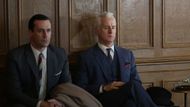Mad Men has always been about reflections - mirrors of identity, power, and desire.
And no two characters mirror each other more fascinatingly than Don Draper and Roger Sterling. At first, Don comes across as the ambitious self-made man, while Roger is the silver-spooned heir living solely on privilege.
But when you look closer, you’ll see that Don also becomes the man he once mocked. In many ways, Mad Men shows that Don Draper didn’t just learn from Roger Sterling, but he eventually became him.
When Don judged Roger, he was really judging his own future
In Mad Men, one of the most telling parallels between Don Draper and Roger Sterling begins with love, or at least what passed for it in their world. Roger’s impulsive decision to leave his wife, Mona, for his young secretary, Jane Siegel, made Don roll his eyes.

He called it foolish, pathetic even. Yet, only a few seasons later, Don broke his own so-called rule about “not sleeping with the help” when he had an affair with his secretary Alison.
By the time Don married Megan Calvet, another secretary, Roger’s mistake had turned into Don’s pattern. Psychologist Dr. Faye Miller even warned Don during their affair that he’d be “remarried by the end of the year,” and boy was she right.
Hence, the irony here is notable. Don became exactly the man he criticized and disliked. Both men chased youth and excitement only to end up lost in their own dissatisfaction.
Even their failed marriages followed a similar pattern. Roger’s with Jane and Don’s with Megan both began with excitement and eventually ended in the same way. When Megan left advertising for acting, Don took it as a rejection of himself, just as Roger did when Jane wanted more than his money.
It’s as if Mad Men used these two men to prove that no matter how different their origins, heartbreak always looks the same.
Honesty versus illusion in Mad Men - Roger lived his truth, Don sold his
There’s a sharp contrast that Mad Men fans love to dissect - Roger Sterling’s blunt honesty versus Don Draper’s carefully built illusion. Roger might be cynical, but he’s rarely fake.

In Season 5’s Far Away Places, his drug-fueled confession to Jane about their collapsing marriage is pure Roger, as it is all over the place, but it's also real.
John Slattery once told The Hollywood Reporter that Roger “has no filter, which makes him oddly honest," and this surely sums him up to the very T.
Don, on the other hand, built his entire identity on a lie. His name, his confidence, his charm. You know that all of it is carefully crafted to sell both ads and himself. Jon Hamm once said to The Guardian that Don “believes in his own pitch until it kills him,” and that couldn’t be truer.
Even when he critiques people like Cassius Clay for reinventing themselves, he’s really projecting his own self-deception.
Roger sells charm, Don sells dreams. Roger is content with what he is, while Don keeps chasing something he insists doesn’t exist, i.e, happiness.
By the final season, Roger’s calm acceptance of his age and place in the world feels almost noble next to Don’s desperate search for meaning. In Mad Men, one man survives his own honesty while the other drowns in his invention.
Mad Men cleverly sets up Don Draper and Roger Sterling as two sides of the same coin. One is polished with lies, the other has the truth. Don thought he was rewriting Roger’s story, but he was only tracing it with a darker pen.
The show’s brilliance lies in that parallelism because, in the end, both men were selling illusions. Roger just happened to know it was a joke.
Stay tuned to SoapCentral for more.
